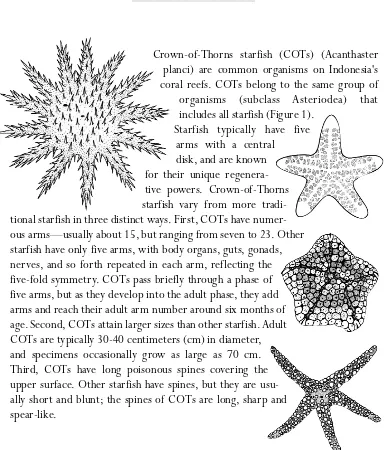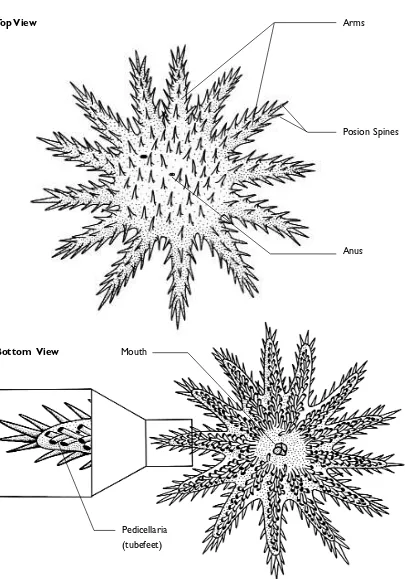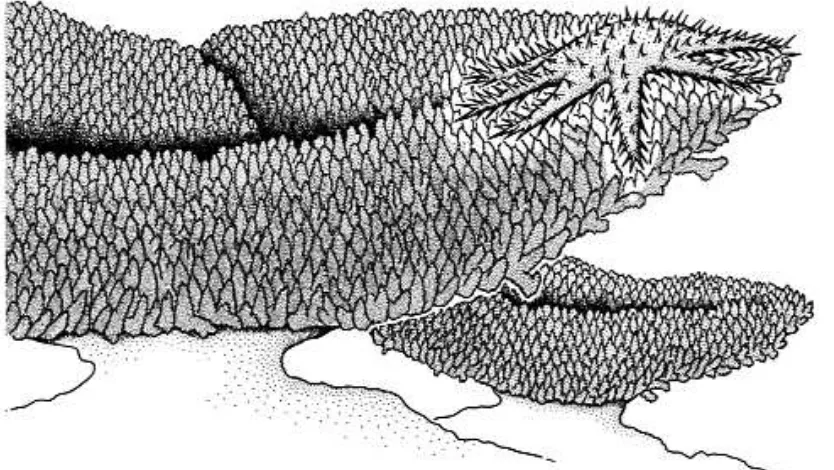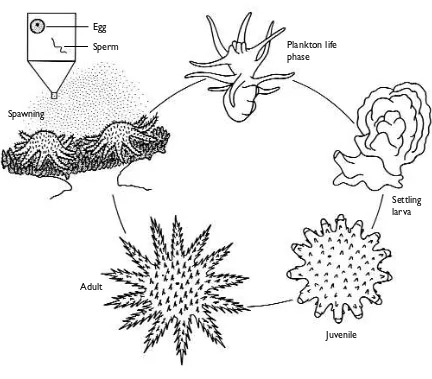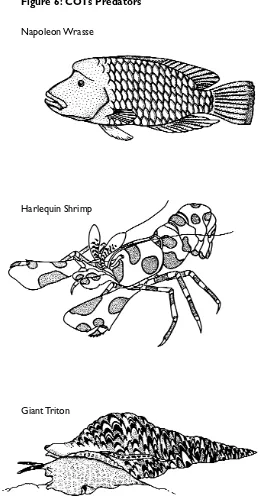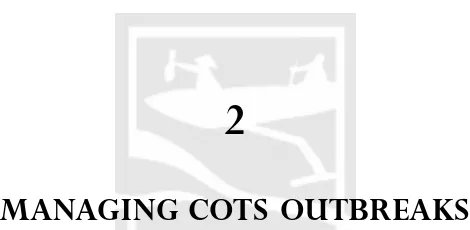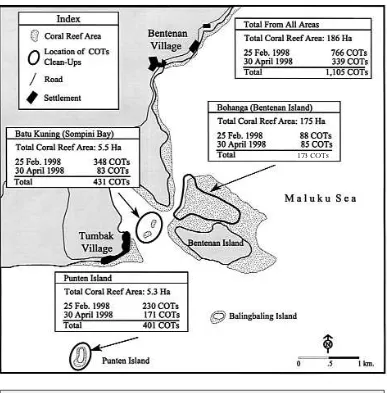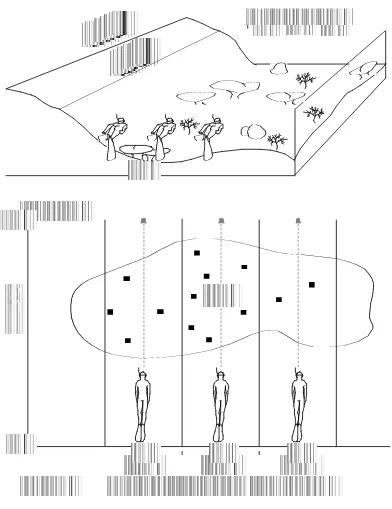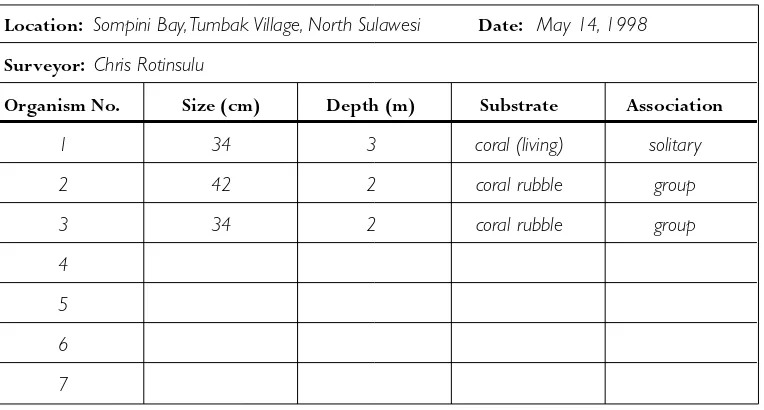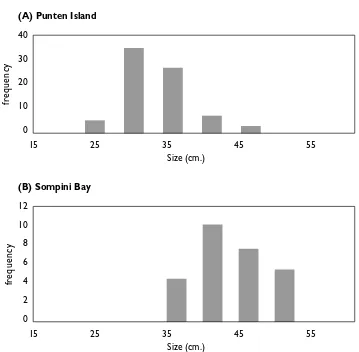CROWN-OF-THORNS
CLEAN-UPS
Nicole Fraser, Brian Crawford, and Janny Kusen
Proyek Pesisir – CRMP Indonesia
May 2000
COASTAL RESOURCES CENTER
COASTAL MANAGEMENT REPORT #2225
Proyek Pesisir, CRC/URI CRMP, NRM Secretariat, Ratu Plaza Building 18th Floor Jl. Jenderal Sudirman 9, Jakarta Selatan 10270, Indonesia
By
Nicole Fraser, Brian Crawford and Janny Kusen
Funding for preparation and printing of this document was provided by USAID as part of the USAID/BAPPENAS Natural Resources Management (NRM) Program
and
USAID-CRC/URI Coastal Resources Management Program.
Further details of Proyek Pesisir publications can be found at www.indomarine.or.id Further details of NRM publications can be found at www.nrm.or.id
Further details of CRM Program publications can be found at www.crc.uri.edu
Printed in Narragansett, Rhode Island USA
Citation:
Fraser, N., B.Crawford, and J. Kusen (2000), BEST PRACTICES GUIDE FOR CROWN-OF-THORNS CLEAN-UPS. Proyek Pesisir Special Publication.
Coastal Resources Center Coastal Management Report #2225. Coastal Resources Center, University of Rhode Island, Narragansett, Rhode Island. 38 pages.
Credits:
Illustrations: Mathew D. Squillante
Maps: A. Siahainenia
Layout: David Kendrick
Edited by: Alice Barrows and Chip Young
Page
List of Figures v
List of Tables v
Acknowledgments vi
About This Guide vii
1. INTRODUCTION 1
1.1 Morphology 2
1.2 Behavior and Feeding 2
1.3 Defense 4
1.4 Life Cycle 6
1.5 Predators 8
2. MANAGING COTS OUTBREAKS 9
2.1 COTs Outbreaks 9
2.2 Confirming a COTs Outbreak 12
Community Interview 12
Reef Survey 13
2.3 Deciding When a Clean-Up Is Needed 17
3. SELECTING COTS CONTROL OPTIONS 19
3.1 Removal and Burial Ashore:The Preferred Method 19
3.2 Poison Injection 21
3.3 Underwater Fences 21
3.4 Cut-Up 21
3.5 Bounty Programs 22
4. WHOM TO ENLIST IN A CLEAN-UP EFFORT 23
4.1 The Local Community 23
4.2 University Faculty and Students 23
4.4. Government 24
4.5. Environmental Non-Government Organizations (NGOs) 24
5. PLANNING AND CONDUCTING A COTS CLEAN-UP 25
5.1 Weeks Before 25
5.2 The Day Before 26
5.3 The Clean-up Day 26
5.4. Post-Clean-up 27
Review of COTS Clean-Up Procedures 28
References and Further Reading 29
Appendix I: COTs Survey Sheet 31
Appendix II: Planning Checklist 32
Appendix III: First Aid for COTs 33
Appendix IV: Fact Sheet (English) 34
Page
Figure 1: COTs and other echinoderms (starfish) 1
Figure 2: Morphological sketch of COTs 3
Figure 3: Acropora vs. non-Acropora Corals 5
Figure 4: COTs feeding scars on a coral reef 5
Figure 5: The life cycle of COTs 7
Figure 6: COTs predators 8
Figure 7: Number of COTs removed from reefs in the Bentenan-Tumbak area 11
Figure 8: A reef swim survey team 14
Figure 9: Size class distribution of COTs in two areas of North Sulawesi 16
Figure 10: Gear used for COTs clean-ups 20
LIST OF TABLES
Page
Table 1: Criteria for determining types of COTs outbreaks 9
The coral reefs of Indonesia are currently under threat of degradation from both natural and human activities. Human destruction of coral reefs by bomb fishing, cyanide poisoning or anchor damage is now the target of a variety of public awareness campaigns. Natural causes of reef degradation include typhoons, earthquakes, tsunamis, coral bleaching from above-normal sea surface temperatures, and Crown-of-Thorns (COTs) starfish outbreaks. While human causes can be controlled and reversed, natural causes are more problematic. Outbreaks of COTs, however, some-times offer an opportunity for successful human intervention.
Crown-of-Thorns starfish are naturally occurring organisms on Indonesia's coral reefs. Their main food sources are corals such as Acropora (karang jari). However, at times the population of COTs exceeds normal levels. Like other biological infesta-tions (for example, locusts infesting paddy fields), COTs outbreaks can cause extremely rapid destruction of an ecosystem (coral reefs) in a matter of months. In recent years, reports of COTs outbreaks have increased. With increased media atten-tion and resulting public awareness, many people now wish to protect the vulnerable, but socioeconomically and biologically important coral reef areas. With responsible intervention, the damage of COTs outbreaks can be decreased by a COTs cleanup, thereby protecting the health of a reef.
This guide is written for anyone concerned about COTs infestations who is con-sidering a COTs clean-up. Information on COTs biology is provided so the potential clean-up team can understand the nature of COTs, lead public education activities on them and be able to answer some of the more common questions. Survey and inter-view guidelines are provided to determine if a coral reef area is experiencing a COTs outbreak, and whether or not a clean-up is warranted. If so, further information is offered on how to lead a COTs clean-up. This guide concentrates on COTs cleanups in Indonesia and one particular method: physical removal of COTs from the reef and burial ashore. However, each coral reef area is unique and poses a different set of complexities. In addition, each organization’s capacity and resources may vary. The methods detailed in this guide are best practices based on Proyek Pesisir's experience with COTs clean-ups in North Sulawesi. Potential clean-up teams may wish to adapt or modify these recommendations to meet their specific circumstances.
COTs damage and to ensure the success of the clean-up. A potential clean-up team must be willing to make this long-term commitment, and be able to secure enough resources (financial and personnel) to maintain a COTs clean-up program for a suffi-cient period to be effective.
The strategy recommended in this guide for a COTs clean-up follows the seven steps listed below:
1. Determine whether there is a COTs outbreak. 2. Decide if a clean-up is needed.
3. Plan the clean-up. 4. Conduct the clean-up.
5. Return to do a post-survey to ascertain the effectiveness of the clean-up. 6. Monitor the area and undertake additional clean-ups as needed.
7. Publicize the clean-ups and publish results.
INTRODUCTION
Crown-of-Thorns starfish (COTs) (Acanthaster planci) are common organisms on Indonesia's coral reefs. COTs belong to the same group of organisms (subclass Asteriodea) that includes all starfish (Figure 1).
Starfish typically have five arms with a central
disk, and are known for their unique regenera-tive powers. Crown-of-Thorns starfish vary from more tradi-tional starfish in three distinct ways. First, COTs have numer-ous arms—usually about 15, but ranging from seven to 23. Other starfish have only five arms, with body organs, guts, gonads, nerves, and so forth repeated in each arm, reflecting the five-fold symmetry. COTs pass briefly through a phase of five arms, but as they develop into the adult phase, they add arms and reach their adult arm number around six months of age. Second, COTs attain larger sizes than other starfish.Adult COTs are typically 30-40 centimeters (cm) in diameter, and specimens occasionally grow as large as 70 cm. Third, COTs have long poisonous spines covering the upper surface. Other starfish have spines, but they are usu-ally short and blunt; the spines of COTs are long, sharp and spear-like.
1.1 MORPHOLOGY
On the undersurface, COTs have a large central mouth and rows of tube feet with suck-ers down a groove on each arm. On the upper surface are a number of structures that can be seen only by careful examination: an anus, situated near the middle of the central body region (the disk), a number of small stony bodies occurring around the outer portion of the disk (madreporites) and numerous pairs of tiny pincer-like spines that are used to clean the upper surface (pedicellaria). Papulae are small finger-like sacs that project through the sur-face and are used for respiration and water circulation.At the tip of the arms there are small pink light-sensitive structures surrounded by specialized tube feet. These are sensory ten-tacles that wave about to detect chemical signals in the water (Figure 2).The color of COTs varies from gray to blue, purple and red.
If cut up, most starfish can regenerate arms and other parts quickly. Sometimes, two starfish can grow from the pieces of one starfish. COTs, however, have limited powers of regeneration. Damaged individuals with regenerating arms are common, and two halves may survive when an individual is divided in two down the middle (bisected). However, unlike other starfish, COTs fragments and detached arms will not regenerate into a whole new individual.
1.2 BEHAVIOR AND FEEDING
Because COTs are radially symmetrical (structures are repeated around a central ver-tical axis, like the petals of some flowers), they have no front or back, and move with ran-dom arms leading. The hundreds of tube feet under the arms move the animal slowly, usually at a rate of 10 cm per minute. Each tube foot reaches forward and attaches to the substrate (coral, rocks or sand) by its suckers. The tube foot contracts, pulling the starfish forward, then it detaches and reaches forward again.
Figure 2: Morphological sketch of COTs
Top View
Bottom View
Anus Arms
Posion Spines
(Lassig, 1995). During a COTs outbreak, hundreds or thousands of COTs are concentrated in a small area. For example, on Haruku Island, near Ambon, 300 COTs were recorded in a one-square meter area. (LIPI-Ambon, 1998. Personal communication.) At these densi-ties, large patches of reef can be destroyed quickly.
The COT detects its food by detecting chemical signals in the water (chemoreception). It also senses, perhaps, the presence of other starfish, and definitely the presence of other spawning COTs. Concentrated in the sensory tentacles at the tips of the arms, the organs that receive the chemical signals wave actively on the leading arms as the starfish moves. COTs can sense each other at a distance of several meters or more.
Typically, COTs remain hidden beneath coral during the day, and are active at night. This behavior changes when the starfish are numerous and competition for food forces them to seek food both day and night. It is at these times that COTs aggregate on reefs. What distinguishes them from other coral predators (fishes, crabs, nudibranchs, gas-tropods, or encrusting sponges), is the extent of coral death that they can cause during peri-ods of high population densities. No other coral predators have been reported to cause significant levels of coral damage in such a short period of time. In the Togean Islands of Central Sulawesi, more than 80 percent of the living coral of a single reef was destroyed by a COTs outbreak in only a few months (Newman, 1998). During a similar outbreak in Guam, COTs killed over 90 percent of the coral reefs at the rate of one kilometer of fring-ing reef per month (Chesher, 1969).
1.3 DEFENSE
Figure 3: Acroporaand non-AcroporaCorals
AcroporaCorals
Non-AcroporaCorals
1.4 LIFE CYCLE
Identical in external appearance, equal numbers of males and females are usually found among COTs populations. In areas of strong seasonality, such as the Great Barrier Reef, gonads (sex organs) develop beginning in late winter (August) as the water temperature rises; they breed in mid-summer (January). Spawning has rarely been observed. COTs climb onto high points, such as the upper branches of corals, where they shed their eggs or sperm into the water through pores on the upper surface of their arms. Many COTs will spawn simultaneously in a group if they are stimulated by stress or by the spawn of other COTs.The different phases of the COTs life cycle are depicted in Figure 5.
Tens of millions of tiny eggs (1.2 mm in diameter) are released by large females into the water column. Sperm, released by male COTs, swim to eggs. As each egg is penetrated by a sperm, its membrane swells away from the yolk to prevent further sperm from enter-ing. Fertilized eggs become planktonic larvae and thus are carried away from the breeding sites by water currents, sometimes over the surfaces of coral reefs, and at other times into the open ocean far from the reefs.
Within a day, the fertilized egg hatches and a gastrula larva emerges. Starfish develop-ment is complicated and has several larval stages. As larvae, COTs swim and feed in the open ocean water using small hairs called cilia. Rather weak swimmers, they can be trans-ported by currents hundreds of kilometers from the original breeding site. After a period of several weeks, if larvae are carried over a coral reef, they settle out of the water column and attach to algae-coated surfaces, such as those of coralline algae. After the COTs larvae settle, they change dramatically into the initial cream-colored, five-armed juvenile starfish, usually only 0.7 mm in diameter. Far too small to feed on coral, juvenile COTs feed on algae, favoring the abundant coralline algae, for about six months. After seven months, the COTs have grown to about 10 mm in diameter and have begun adding arms to reach their adult configuration. They then begin to feed on coral polyps. Growing rapidly, they reach about 5 cm at one year of age, 20 cm at two years, and 30 cm or more at three.
Figure 5: The life cycle of COTs
"What happens to the millions of eggs that are released by every female each year?"
COTs are exceptional among other starfish in their ability to produce many eggs and sperm (fecun-dity), but other marine invertebrates also release millions of eggs. Usually there is a pattern of extremely heavy mortality for eggs, as well as for the early developmental stages, and only a very small percentage survive even a few weeks. First, not all eggs are fertilized. Ocean currents can carry eggs and sperm far away from each other. Also, COTs at low population densities are less likely to achieve successful fertil-ization. Finally, even if the eggs are fertilized, many organisms (coral polyps, feather stars and reef fish) eat the planktonic larval COTs.
Mortality is undoubtedly high for larval COTs. However, if a female starfish reproduces for three or four successive breeding seasons, her total egg release will be on the order of 100 million eggs.To replace herself and a male, only two individuals out of 100 million need to reach sexual maturity, a rate of 0.00000002 percent (2 out of 100 million). If, instead, the survival rate is 0.001 percent (similar to other highly fecund marine invertebrates) there will be a population outbreak of 1,000 starfish where otherwise there would have been only two.The survival rate of larvae that become juveniles (larval recruitment) is a key factor for determining the population of juvenile and adult COTs on a reef.
Egg
Sperm Plankton life phase
Settling larva
Juvenile Adult
1.5 PREDATORS
Juvenile COTs have chemical defenses, but they lack the poisonous spines of adult COTs.Therefore, they are easy prey for organisms that can locate them and are protected against their defense. Reef crabs and some fish are known to prey on juvenile COTs.
Some fish such as toad fish, trigger fish and the Napoleon wrasse have been observed to feed on adult COTs. The fish avoid the poisonous COTs spines by turning the starfish over and attacking its undersurface. The giant triton (Charonia tritonis) and the painted shrimp (Hymenocerapicta) are also COTs predators (Figure 6).
Figure 6: COTs Predators
Napoleon Wrasse
Harlequin Shrimp
MANAGING COTS OUTBREAKS
Before starting a COTs clean-up, interviews with representatives of the local com-munity and a reef survey of the suspected COTs outbreak areas will provide sufficient information for determining whether an outbreak is occurring. If, indeed, it is, then the team should decide whether or not to take action. Not every situation warrants a clean-up. If the area meets certain criteria favoring a clean-up, then a method is chosen. The "removal and burial ashore" method, considered the most appropriate, cost-effective and simple, is recommended for Indonesian community-based clean-up programs. After a clean-up, surveys and smaller repeat clean-ups will be needed to monitor and preserve the integrity of the target reef area.This section outlines the two initial steps in the manage-ment of COTs outbreaks—the methods, procedures and criteria for determining whether an outbreak is occurring and whether a clean-up is warranted.
2.1 COTS OUTBREAKS
Outbreaks are difficult to define, as each coral reef area is unique. Some coral reefs may be able to sustain large numbers of COTs without irreversible damage; others cannot.There are, however, some rough guidelines. The Great Barrier Reef Marine Park Authority (GBRMPA) uses the criteria outlined in Table 1 for its management activities (Englehardt, 1997).
Table 1: Criteria for determining types of COTs outbreaks
Outbreak Type Criteria
Non-Outbreak Fewer than 30 COTs per hectare of reef
Incipient Outbreak High densities of juveniles, likely to survive and reach maturity Spot Outbreak High density populations of COTs on parts of a reef,
low numbers elsewhere.
The villages of Bentenan and Tumbak in North Sulawesi, for example, were experi-encing a spot outbreak. In only a few areas of the reefs were there high-density numbers of COTs. However, in other nearby sections of reef flat or nearby islands, COTs numbers were normal or completely unobserved. Figure 7 shows a map of the Bentenan-Tumbak area with the numbers of COTs removed and the area of estimated reef flat controlled.
During a COTs outbreak, COTs cluster together and devour the living coral, leaving behind a white graveyard of dead coral. After a few weeks or months, the dead coral becomes covered in brown algae. The COTs eventually die of starvation when they have eaten all of the living coral. After a particularly large COTs outbreak in Guam, the reef took 10 years to recover (Chesher, 1969).While in the Ryukus of Japan, COTs outbreaks continued from 1967-1987, and the reefs were completely destroyed after 20 years (Yamaguchi, 1987).
The true causes of COTs outbreaks are not known at this time, though hypotheses abound. Outbreaks do occur naturally. Scientists, researching a possible link with human activities, have proposed that the overfishing of COTs predators, Napoleon wrasse and tri-ton shells, may be responsible.
The more accepted current theory is that COTs outbreaks are due to increased sur-vival rates of COTs larvae and juveniles, again for reasons unknown. Similarly, human activities are suspect: too many pesticides and fertilizers used in farms. Rivers near the farms carry these chemicals to coral reefs where they may create an environment con-ducive to larval recruitment. Natural factors may also increase larval survival. It has been demonstrated that elevated water temperatures and decreased salinity during spawning, and before the larvae settle, both increase the survival rate.
It would be more effective to manage the causes of outbreaks rather than the out-breaks themselves. However, this is not yet possible. Until the causes are understood, tem-porary control efforts are necessary to protect coral reef areas, particularly those of socioeconomic and biological importance (i.e., reefs which are breeding grounds for important fish species, attract tourists, or exhibit high marine biodiversity). The goal of any control program should be to reduce or prevent the impact of a COTs outbreak on the coral community.As coral reefs are made of relatively slow-growing organisms, recov-ery from a COTs outbreak, as cited above, may take years.
Figure 7: Number of COTs removed from reefs in the Bentenan-Tumbak area
"Why don’t we kill every COTs we see on the reef?"
Every organism in an ecosystem has a role. Only when the ecosystem is out of balance, when there are too few or too many of one organism, should we take action. COTs are naturally occurring organisms on a coral reef. In low densities, COTs help to trim back the fast-growing Acroporaspecies and allow space for other slow-growing massive forms of coral.Therefore, COTs at normal population levels may actually help maintain diversity on a coral reef. COTs are prey for other organ-isms on the reef. Removing all the COTs takes food away from fish, tritons and shrimp.
2.2 CONFIRMING A COTS OUTBREAK
To determine if a coral reef area is currently experiencing an outbreak, it is important to conduct a COTs survey first. However, in some areas COTs have demonstrated cycli-cal populations that do not necessarily damage coral reefs. Incipient, spot and active out-breaks (see Table 1) are all good candidates for clean-up efforts. Interview people in the adjacent communities who use the reef area potentially under threat. Residents often have local knowledge, which can illuminate the historical context of the current COTs popula-tion. Community interviews should always be supplemented by reef surveys of suspected COTs outbreak areas.
Community Interview
An interview with people in the community about the characteristics of COTs den-sity in the area is critical. Many coastal communities have traditional knowledge or his-torical facts about a coral reef that a one-day survey cannot discover. It is especially important to involve people who make frequent direct observations of the coral reef (e.g., spearfishers or aquarium fish collectors), particularly those with many years’ experience. Interviewers should carefully avoid asking leading questions. Informal oral interviews with several individuals (key informants) or small groups of people (two or three) are most suc-cessful. Suggested questions to ask coral reef users or village elders include:
• Are there COTs on the reef? If so, are they numerous or spotted only occasionally?
• Have you noticed any changes in COTs populations over the past year? Five years? Ten years? Twenty years? If so, explain in more detail.
• In your opinion, what happens to the coral if there are many COTs?
• Do some reef areas have more COTs than others? If yes, which areas?
• Have there been any recent changes in reef conditions? If yes, what do you think is causing those changes?
If the community feels that COTs are a pressing issue, ask the community (particu-larly reef users) to draw a map of the reef, showing the locations that have large numbers of COTs.This will help pinpoint possible outbreak areas for swim-surveys.
health have not declined. Researchers and fishermen believe that these COTs populations may be controlled by large fish predators (Ormond et al., 1990). Nonetheless, a reef sur-vey is still worthwhile to corroborate community perceptions. The reef may be experi-encing the start of an unusual increase in COTs numbers, well above historic levels as reported by the community. Decisions about clean-ups should be made carefully, without haste. Prudence may dictate monitoring an area every few months, until it is certain that an intervention is needed and justified.
If the COTs infestation is a one-time occurrence, without historical precedence, then the coral reef is potentially endangered. Community interviews providing the context of a COTs outbreak help balance reef survey information for a well-reasoned decision.
Reef Survey
An area of the coral reef suspected of experiencing an outbreak of COTs should be sur-veyed by carrying out a visual transect of 100 meters or more. In this, a team of three swim-mers (wearing masks) swims about three meters apart, parallel to shore. Each survey member is responsible for a three-meter wide band (Figure 8). The search must be thor-ough, checking under overhanging corals and crevices, and particularly on and around small bleached spots that are signs of COTs feeding. If a transect is not a feasible option for the potential control area, then an estimate of the size of the area to be controlled and a record of the length of time spent looking for COTs will suffice. It is important to record the name of the location and the position (preferably with latitude and longitude) of the reef area for complete records. For many locations in Indonesia, COTs are at relatively shallow depths; in North Sulawesi, most have been spotted in depths less than three meters.
Manta tows are another common method for monitoring COTs populations. A manta tow is a survey method whereby a snorkeler (holding a wooden board with a writing slate for taking notes) is towed at slow speed behind a boat. Refer to the Australian Institute of Marine Science (AIMS) manual for the manta tow procedures (English et al. 1994). In a manta tow survey, the surveyor is towed behind a boat at a speed greater than anyone could swim but at about a walking pace.This method is ideal for cataloguing large areas of reefs but the surveyor does not leave the tow-line and has a fixed view of the reef. Thus, manta tows tend to underestimate COTs populations. Swim surveys have greater accuracy as they allow opportunities to search for COTs in their habitual crypts: under coral heads and inside crevices.
Scuba gear and scuba divers are not necessary unless the COTs population is deeper than four meters. Snorkeling survey teams of Proyek Pesisir staff and community mem-bers (male and female) were able to record COTs data comparable to the scuba diving teams deployed in the same area. It is possible also to have a mixed team of half scuba divers and snorkelers. Snorkelers point out COTs while the scuba divers carry the meter stick and the underwater slate. (The snorkeling team will need fins to keep up with the scuba team.) Table 2 is an example of a survey sheet with field data recorded. (Appendix I is an empty survey sheet which can be photocopied.) For all COTs sighted, the follow-ing data is recorded on an underwater slate, and copied onto a survey sheet ashore.
• Size (diameter in cm) • Depth found
• Associated substrate (type of coral, sand, rubble, etc.) • Association in groups or single organisms
Table 2: Sample survey sheet
Size gives a rough estimate of the age of the COTs. Analyze your data by constructing a size-frequency diagram as illustrated in Figure 9. Take into account the other data col-lected (substrate, association, and community information) to help determine the severity of the possible outbreak. Is one size-class of COTs more common than the others? If so, estimate the age of the COTs by their size. If all are roughly about the same median size (same age-class), that indicates a successful recruitment at one point in time. For exam-ple, at three years a COT is usually 35-40 cm in diameter if it has had sufficient food. Commonly, in an outbreak situation, one size-class will dominate the rest, indicating that a successful larval recruitment at one time led to the current infestation.
Location: Sompini Bay, Tumbak Village, North Sulawesi Date: May 14, 1998
Surveyor: Chris Rotinsulu
Organism No. Size (cm) Depth (m) Substrate Association
1 34 3 coral (living) solitary
2 42 2 coral rubble group
3 34 2 coral rubble group
4
5
6
Figure 9: Size class distribution of COTs in two areas of North Sulawesi
(A) COTs size distribution from Punten Island.This population is approximately two years old as the median size-class is 30-35 cm.
(B) COTs size distribution from Sompini Bay.This population is approximately four years and older as the median size-class is 40-45 cm.
The depth at which the COTs are found is important because anecdotal evidence of outbreaks suggest that some start from deeper water and move into shallower waters. Associated substrate gives an idea about the intensity of an outbreak. As explained earlier, COTs prefer to feed on Acropora; if they have switched to other slower-growing more massive corals, it suggests that they may have exhausted the Acropora source in that area and are switching prey. If a COT is sighted on rubble or sand during the day, this suggests foraging behavior—food is decreasing so it may be traveling to another feeding spot in an attempt to find more live coral. Aggregations also suggest outbreak levels, whereas soli-tary COTs are more benign.
fr
equency
(A) Punten Island
40
30
20
10
00
0 15 25 35 45 55
Size (cm.)
fr
equency
(B) Sompini Bay
12 10
08
06
04
02
00
0 15 25 35 45 55
None of these criteria alone determines the existence of an outbreak; rather, they work in concert. For example, COTs at one Proyek Pesisir clean-up site in Sompini Bay were highly aggregated, and all of the same age-class, but restricted to Acropora corals. Interpreting reef survey data requires the supplementary community interview described above.
2.3 DECIDING WHEN A CLEAN-UP IS NEEDED
If information from both the reef survey and the community interview point to an outbreak, several other criteria still must be considered before deciding whether a clean-up should be undertaken. To insure the success of a COTs cleanclean-up, experience from around the world indicates that the following conditions should also be met:
• The reef damage from COTs or human activities is not already too extensive
• The reef area is small enough to monitor. Five hectares is manageable; over 200 hectares is probably too large
• The population of COTs is small enough to maintain effective control
• A quick-clean-up response can be mounted once an outbreak has been discovered
If the coral cover is extremely low, or the area is already experiencing severe degrada-tion from factors other than a COTs outbreak (bomb fishing, heavy silting), it may not be worthwhile to conduct a COTs clean-up. In this case, it may be too late to prevent reef damage from COTs, and COTs may not be the major cause of reef change. Also, removing COTs may not necessarily lead to reef recovery, as other factors may prevent it. If a coral reef area is too large, it is difficult to mount a successful clean-up campaign and sustain the effort over a period of several years. COTs clean-ups are labor-intensive projects and require a commitment of up to three years for post-monitoring and smaller repeat clean-ups. It is essential to sustain the program throughout the entire period to ensure success.
Also important to consider is whether or not the area is healthy enough to warrant a clean-up effort. It is best to focus efforts on small areas of healthy reefs that are of value to coastal communities for tourism, fisheries, and erosion prevention, or because they have a unique biodiversity role.These areas should receive priority for clean-ups.
areas of reef may be killed before a clean-up operation begins, and further increases the danger to neighboring areas, which may become infected with their spawn. Quick action is essential. A few months’ delay may mean the difference between success and failure.
"Why should we sometimes not clean up COTs, even if there is an outbreak?"
Tampering with a complex ecosystem such as coral reefs may initiate a series of unknown and potentially undesirable outcomes.Two often-cited reasons to leave COTs populations alone, even if they are at outbreak level, are:
1. Outbreaks of COTs may actually help maintain the species diversity of corals.
2. If too many COTs are removed, the ecosystem may be thrown out of balance. The ecological hole created by the COTs removal may decrease competition for food and result in the persistence of a few highly fecund adult COTs. As a result, the number of COTs larvae may increase and with a constant survival rate the population could return to outbreak levels or worse (Birkeland and Lucas, 1990).
In each particular area, we must decide first whether a clean-up is likely to achieve the goal of saving the coral reef, and then whether saving the reef in question is justified.
SELECTING COTS CONTROL OPTIONS
In Indonesia, the recommended option for most small-scale community-based clean-up efforts (less than 5,000 COTs in the area to be removed) is hand-removal and burial ashore. Other control options used elsewhere in the world for small areas include injec-tion of poison, use of underwater fences or cutting up COTs.
3.1 REMOVAL AND BURIAL ASHORE:
THE PREFERRED METHOD
Figure 10: Gear used for COTs clean-ups
Rattan or bamboo basket “Karamba”
Fish basket “Jamala”
Sea cucumber spear “Ganculi” Metal COTs spear
Bamboo tongs
Bamboo COTs spear
Traditional spear from a spear gun “Mata pana”
Once all the COTs are collected, participants return to shore. The most common method of disposal is burial on land or on the beach, but above the high tide level. COTs should be buried high enough that they will not have further contact with the sea, and deep enough that spines are not easily exposed, risking harm to people (especially children) or to animals digging in the sand.When exposed to stress (such as spearing during clean-up), COTs will attempt to spawn as a last ditch effort for survival of their kind.Therefore, it is imperative to remove COTs from the water as quickly as possible, and place them in the boat. If possible, prevent reimmersion of collected COTs, as they may release gametes (eggs and sperm) in response to the stress from the clean-up.
3.2 POISON INJECTION
This method is used by some of the large-scale, government-funded COTs clean-ups of the GBRMPA. Currently, sodium bisulfate (dry acid), Na(S04)2, is recommended, because it is effective, relatively inexpensive, widely available and causes less damage to the environment when handled correctly (Lassig, 1995).The poison is injected using a plastic syringe or, more commonly, a DuPont Velpar Spot Gun. Long needles minimize the risk of injury from COTs spines to the injector. A large reservoir is also an advantage as it decreases the number of times an injector has to refill. Each liter of seawater is mixed with 140 grams of sodium bisulfate powder. Because the solution is colorless, food coloring is added to confirm that the injector is working. Other poisons that have been used include copper sulfate (CuSO), formalin, concentrated aqua ammonia solution, and hydrochloric acid. Some are not as safe as dry acid, as they tend to damage the injection guns, and are more hazardous to the injector in case of an accident.
3.3 UNDERWATER FENCES
Because some areas are prone to recurring COTs outbreaks, some COTs clean-up teams have attempted to construct underwater fences to prevent adults from migrating into a previously cleaned area, and decrease the need for continual removal.These fences work to keep adults out; however, fences cannot stop migration of larvae. Fences also reduce the aesthetic value of a coral reef area.This is an extremely expensive option that works best in very small areas, no more than one hectare.
3.4 CUT-UP
into quarters or most of the central disk is removed. This method is time-consuming, requires participants to scuba dive, and increases the chance of injury from spines. Proponents suggest that it is preferable to other methods because it returns biomass to the reef ecosystem.
3.5 BOUNTY PROGRAMS
WHOM TO ENLIST IN A CLEAN-UP EFFORT
If you elect to use the removal and burial ashore method, a clean-up team will need many people. Of two clean-ups in North Sulawesi, one involved over 250 people, and a smaller one utilized 120 people. Potential volunteers come from all walks of life, and are united by a commitment to protect Indonesia's coral reefs. A clean-up activity can galva-nize different stakeholders, and create partnerships among diverse groups of people. For the Proyek Pesisir COTs cleanups, the first large scale COTs clean-up involved as many different stakeholders as possible (university students, govemment officials, the local dive community, tourists and villagers).The repeat clean-up concentrated on the villagers, who then provided the entire work force.
4.1 THE LOCAL COMMUNITY
Dependent on the reef’s health for their livelihoods, local residents are the most important people to involve. Many community members have local knowledge about the conditions of the reef flats and are proud to share their expertise. They can also provide boats and other gear to help keep the cost down.
4.2 UNIVERSITY FACULTY AND STUDENTS
4.3 PRIVATE SECTOR
(DIVE OPERATORS AND TOURIST RESORTS)
This is an activity that many eco-tourists may enjoy; therefore many dive operators are willing to participate, particularly if a clean-up is on a reef frequented by tourists and important to the survival of their business. Dive tourists demand healthy reefs with plenty of coral and fish. Degraded or dead reefs covered with algae attract few fish and fewer tourists. Dive operators should supply their own gear, and may be willing to loan gear on the day of the clean-up to other participants who need it.
4.4 GOVERNMENT
Local government officials from village to provincial level may be invited when appro-priate. Inviting them lends an official air to the event, and helps educate some of the deci-sionmakers and resource managers about threats to the coral reefs. Agencies that may be willing to assist with a clean-up include: Natural Resources Conservation Office, Fisheries Office, Forestry Office, Environmental Office, Tourism Office, Navy, or Water Police. It may also be appropriate to invite other officials from the provincial, regency, district or village level, especially the village head (kepala desa).
4.5 ENVIRONMENTAL NON-GOVERNMENT ORGANIZATIONS
(NGOS)
United by a passion to maintain and preserve Indonesia's coral reefs, environmental NGOs are unique in this mix because they represent a group of people closely allied with all the other groups. Several NGOs should be encouraged at every clean-up.
PLANNING AND CONDUCTING
A COTS CLEAN-UP
The process of a clean-up requires several weeks of pre-planning and months of fol-low-up. If your COTs population is larger than 30 cm in size, it is probably already three years old, and spawning in large numbers (over 20 million eggs per female). Removing the breeding population before it can spawn can decrease the severity of a COTs outbreak. Once the threat of outbreak has been identified, a quick response is critical to the success of any clean-up. It prevents further reef degradation, and thereby improves the chances of reef recovery. A combination of thorough planning and fast action is the key to success.
5.1 WEEKS BEFORE
In the communities closest to the outbreak area, a public environmental education activity on the importance of coral reefs, with a special focus on COTs and their clean-ups, should be conducted. A fact sheet on COTs (see Appendices IV and V) can be distributed after the meeting for attendees to share with other family members.The community should be asked if it wishes to do a clean-up, and allowed to decide. If it supports a clean-up, a date must be set. Most important in this is checking tides, local fishermen's schedules and other possible conflicts. After the date is chosen, participants must all be invited and the local media contacted, particularly the local newspaper or television stations.Appendix II can be used to assist with your planning activities. COTs clean-ups are positive events that allow large numbers of people to show their commitment to preserving the reefs, and media cov-erage increases public awareness of threats to the coral. These are perfect news stories! Finally, gear for collection and research must be arranged, typically:
• Spears (one meter long, one for every swimmer)
• Baskets (several for each boat team, net bottoms are best)
• Tongs (bamboo or barbecue-style tongs are best for transferring COTs to and from baskets)
• Pencils
• Underwater writing slates for pre- and post-clean-up surveys • Snorkeling sets (mask, snorkel and fins)
Enough boats must be on hand for the estimated number of participants. For safety, boats must not be overloaded with too many people. Only competent swimmers should be allowed to collect COTs; non-swimmers may help on the boat or ashore.
5.2 THE DAY BEFORE
The day before the clean-up, a rapid assessment survey, collecting the same infor-mation as the pre-survey, will update any changes on the reef. It also helps determine where to concentrate manpower. For example, if COTs are dense in one area, it needs more boats.
The day or night before the clean-up, it is a good idea to have an orientation meeting for all participants.This should remind people what COTs are, how to look for them, and how to avoid injuries, as well as first aid procedures. Emphasis on taking care to minimize damage to the coral reef while removing COTs is important, as is a review of the next day’s schedule. Also, team lists for each boat will minimize confusion the next day. For a community-based clean-up, dusun (village) leaders can help by organizing a boat team by dusun for each clean-up site. Every boat team should consist of:
• A boat captain
• A representative of the survey team that can locate and point out the COTs-infested area targeted during the previous day’s survey
• Volunteer assistants on board to handle COTs, transporting from the collectors’ baskets to baskets on the boat
• Volunteer divers or snorkelers to search the reef, spear COTs and bring them back to the boat
5.3 THE CLEAN-UP DAY
A final orientation on the beach before boarding boats reminds the participants not to damage the coral and sets an agreed time for all boats’ return. A final equipment check will insure that all the teams have enough spears and baskets. Team leaders and captains should confirm their assigned sites.
dan-ger and just want to get involved. But injuries can be serious and require immediate med-ical attention. (See Appendix III for a description of first aid for injuries caused by COTs.) Data collection before burial ashore should include the total number of COTs removed and the diameter of each, by location on the reef.The resultant size-class data is useful for monitoring purposes. As explained earlier, size is a rough estimate of a COTs population age-structure, i.e., whether or not they have reached the spawning stage and whether multiple ages of COTs populate the reef. Some clean-up programs can also col-lect data for more extensive research purposes by weighing the colcol-lected COTs or remov-ing spines for studies about the population’s age-structure and possible reasons for the outbreak.
Thanking the community and all volunteers should not be neglected.When everyone is back on shore and the total number and size of all COTs has been measured, a small cer-emony recognizing and rewarding everyone's participation makes a nice finale. Drinks should be available (water, tea or soft drinks) and, if possible, a meal or snack. Ideas for recognition include prizes (for the largest COTs collected, and/or the most and fewest collected), certificates of participation, or T-shirts. Finally, the results of the clean-up (total numbers cleaned off each reef area) should be tallied and reported to the participants; any media representatives present should also be briefed in full.
5.4 POST-CLEAN-UP
COTs Survey Sheet
Location: Date:
Surveyor:
APPENDIX II
Gear and Planning Checklist
WHAT WHO WHEN
First Aid for COTs
Treatment for Minor Wounds During a COTs Clean-up Divers, snorkelers and other COTs clean-up participants can experience a wide variety of wounds.The majority, such as coral wounds or wounds from sharp edges of the spear, are minor and require a mininum of first aid. Minor wounds, abrasions, scratches, etc., may be noticed either at the time they occur underwater, or later ashore. When such wounds are noticed, they should be flushed gently with alcohol or hydrogen peroxide followed by water; iodine is optional. Finally, cover the wound with a sterile dressing, such as gauze pads, and wrap in a bandage, or secure with an adhesive bandage.
Treatment of a COTs Puncture or Sting* Spines that can be grasped should be removed with tweezers; then treat as a minor wound (described above). Spines that have broken off flush with the skin are nearly impossible to remove and probing around with a needle will only break the spines into little pieces. Most of the spines will be dissolved by the body within a week; others may fester and can then be pushed out to the point where they can be removed with tweezers. If infection occurs, urge the participant to see a doc-tor and take antibiotics. Immersing the affected area in hot and cold water may help dis-solve the imbedded fragments.At all times, keep the puncture area clean and covered with a loose bandange.
Traditional Treatment of a COTs Puncture or Sting Local residents of Tumbak vil-lage in North Sulawesi have a traditional method of treatment for COTs punctures or stings. It is suggested that this method of treatment be administered in addition to the pre-scribed treatment mentioned above. If punctured by a COTs spine, turn the COTs starfish on its back and press the affected area of the body (hand, foot, etc.) against the underside of the COTs starfish. Allow the tube feet of the COTs to attach themselves to the punc-tured area and leave the affected area of the body pressed against the COTs for several minutes. It is believed by locals that the COTs tube feet will suck out the poison and that the tube feet have a substance that neutralizes the poison. To our knowledge, this tradi-tional belief or theory has not been tested or verified by western medical science.
APPENDIX IV - FACT SHEET
Crown-of-Thorns (COTs) Clean-ups in Indonesia
Healthy coral reef Unhealthy coral reef What are COTs? fifteen “arms” and are usually blue, but some-times purple or red.To protect itself COTs have short toxic spines that are easily embedded in the skin. An efficient predator, COTs can consume 5-13 square meters of living coral a year. What is a COTs outbreak?
COTs are part of the coral reef ecosystem, usu-ally there are about 1-20 COTs per hectare of reef. However, during an outbreak, the naturally low numbers of COTs increase to over 30 or thousands of COTs per hectare of coral reef.The COTs cluster together and devour the living coral, leaving a white graveyard of dead coral behind. The dead coral becomes covered in brown algae. The COTs eventually die of starva-tion because they have eaten all the living coral possible. In the Togian Islands of Central Sulawesi, more than 80% of the living coral of a single reef was destroyed by a COTs outbreak.
Why are coral reef ecosystems important? Coral reefs provide homes for fish, attract tourists, protect the coast and make sand for beaches. Healthy coral reefs have large fish pop-ulations and plenty of living coral. The coastal communal ties of Indonesia are dependent on coral reefs for food and money. Coral reefs can be destroyed by natural causes, like COTs out-breaks or by human activities, such as bomb fish-ing, cyanide poisoning and coral mining for buildings. If reefs are weakened or destroyed, fish are harder to find, beaches erode and tourists stay away. Indonesian coastal communities will be hurt too.
Why do COTs outbreaks happen?
Outbreaks occur naturally. Specific causes for outbreaks are not well understood. Scientists are researching a possible link with human activities. Some
scien-Triton shells (binawang or triton teruinptet), may have led to COTs outbreaks. While other scientists say it may be a result of too many pes-ticides and fertilizers used in farms. Rivers near farms carry these chemicals to coral reefs. Healthy coral reefs can survive COTs outbreaks better than weak coral reefs.
Crown-of-thorns starfish
Napoleon WrasseHow do we stop COTs out-breaks from happening in Indonesia?
We can not prevent outbreaks from happening but through responsible and safe intervention we can limit the damage from COTs outbreaks. Because coral reef ecosystems are important to the economy and coastal communities of Indonesia, we have to act to prevent further dam-age. Removal of COTs, or a “clean- up”, should be a team effort between the community, scien-tists and the government. Only after all the team members are consulted for advice can a COTs cleanup start. Clean-up programs have been started in Indonesia, Malaysia, Japan and Australia.
How do we clean up a COTs outbreak?
Before starting any “clean-up” program it is nec-essary to know the number of COTs and the size of the area affected. Several factors are important to insure the success of a COTs cleanup: • The reef is not too damaged already by COTs
or human activities,
• The reef area is small enough to monitor, • The population of COTs is small enough to
maintain effective control.
These factors should be assessed with the help of scientists. For most outbreaks in Indonesia, the best clean-up method is physical removal of the COTs from the reef and burial ashore.
Who can clean-up COTs?
Anyone who is interested in helping the marine environments of Indonesia can help on the desig-nated COTs clean-up day. Snorkelers and divers are needed to spear the COTs underwater. Boats and drivers are needed to bring them to shore. People on shore are needed to measure COTs for scientific research and bury COTs. Remember, the short toxic spines are very painful.Never touch a COT with bare hands.Only with a sharp stick or tongs.
Napoleon WrasseAfter the COTs clean-up, are we done?
No, we are just getting started! After the clean-up, return to the site and check to see if the number of COTs has increased or decreased. After a few months have passed, small repeat clean-ups may be necessary. The hardest task of all is keeping Indonesia’s reefs healthy so when COTs outbreaks do occur the ecosystem is strong enough to fight them off.
How do we keep Indonesia’s coral reefs healthy?
There are lots of things we can do to protect our coral reefs and help our coastal communities. Here are just a few:
• Report illegal fishing activities that destroy reefs, such as
coral or buy ornamental shells or coral. Shells are important animals in the healthy coral reef envi-ronment. Especially, the Triton shell that eats COTs.
• Dispose of chemicals and trash properly. Waste thrown into rivers is carried to the ocean where it kills healthy reefs and other marine animals.
• Helpby participating in COTs clean-ups and beach trash clean-ups.
Triton shell
APPENDIX IV - FACT SHEET
Apa itu bintang laut berduri?
Bintang laut berduri (Acanthaster planci) dalam bahasa Inggris disebut Crown of Thorns (COTs) dike-nal juga sebagai kaki seribu laut atau sasanay, terdapat atau hidup secara alami di terumbu karang. Bintang laut berduri dewasa memiliki masuk ke dalam kulit manusia. Biasanya, mereka mulai memangsa karang pada saat ukuran 20 cm. Saat men-capai ukuran 30 cm, hewan ini mulai berkenbank biak dengan cepat. Bintang laut berduri adalah pemakan karang yang sangat berbahaya dan dalam setahun mampu memakan 5 sampai 13 meter bujur sangkar terumbu karang hidup.
Apa itu penyebaran besar-besaran bintang laut berduri?
Bintang laut berduri adalah bagian dari ekosistem terumbu karang pada kondisi normal, biasanya terda-pat 1 - 20 bintang laut berduri untuk tiap satu kilome-ter bujur sangkar. Apabila melimpah dalam jumlah besar maka bintang laut berduri ini dapat mencapai 30 individu sampai ribuan individu per hektar. Hewan ini hidup secara berkelompok dan memangsa terumbu karang hidup sampai hanya tinggal terumbu karang mati saja. Terumbu karang yang mati kemudian akan ditutupi oleh ganggang laut. Bintang laut berduri ini pada akhirnya akan mati kelaparan karena telah memakan habis semua karang yang masih hidup. Sebagai contoh di kepulauan Togian Sulawesi Tengah, sebagai contoh, lebih dari 80% terumbu karang hidup musnah dimangsa oleh penyebaran hewan ini.
Mengapa terumbu karang hidup merupakan ekosis-tem yang penting?
Terumbu karang hidup merupakan rumah bagi berba-gai jenis ikan, menarik wisatawan karena keindahan-nya, dan melindungi pantai dari pengikisan. Terumbu karang yang sehat memiliki jumlah ikan yang banyak dan jumlah karang hidup yang banyak pula. Sebagian masyarakat pesisir di Indonesia sangat tergantung hidupnya pada terumbu karang untuk sumber makanan dan pendapatan mereka. Terumbu karang dapat rusak karena pengaruh alam, seperti penyebaran bintang laut berduri dan kegiatan manusia seperti pengeboman, penggunaan racun potas dan penamban-gan karang untuk bangunan. Jika terumbu karang dirusak maka ikan akan sulit didapat, pantai akan mudah terkikis dan jumlah turis akan menurun. Pada akhirnya penduduk masyarakat pesisir Indonesia sendirilah yang akan mengalami kerugian.
Mengapa penyebaran secara besar-besaran bintang laut berduri ini terjadi?
Penyebaran besar-besaran terjadi secara alamiah, penyebab utamanya belum diketahui dengan pasti. Para ilmuan sedang meneliti kemungkinan hubungan-nya dengan kegiatan manusia. Ada ilmuan yang men-gatakan bahwa ini kemungkinan disebabkan oleh pengambilan yang berlebihan hewan pemakan bintang laut berduri atau predatornya, seperti Maming (Napoleon) dan Triton
yang berlebihan dari pupuk yang digunakan dibidang pertanian. Bahan-bahan kimia ini dialirkan melalui sungai-sungai didaerah petanian sampai ke daerah terumbu karang. Terumbu karang yang sehat akan dapat bertahan hidup dari penyebaran bintang laut ini bila dibandingkan dengan terumbu karang yang lemah atau sakit.
APPENDIX V - FACT SHEET
Pembersihan Bintang Laut Berduri di Indonesia
Terumbu karang sehat Terumbu karang tidak sehat Bintang laut berduri
Bagaimana kita menghentikan penyebaran besar-besaran di Indonesia?
Kita tidak dapat menghindari terjadinya penyebaran bintang laut berduri tetapi lewat penanganan yang aman dan bertanggungjawabkita dapat mengu-rangi kehancuran yang diakibatkan oleh penyebaran-nya. Karena ekosistem terumbu karang sangat penting bagi ekonomi dan penduduk pesisir di Indonesia, maka kita harus bertindak untuk menghindari kerusakan selanjutnya. Pengangkatan atau "pembersihan" bin-tang laut berduri haruslah merupakan keinginan dan tujuan bersama dari kelompok masyarakat, ilmuan dan pemerintah. Hanya setelah anggota-anggota kelompok bersatu untuk saling mendukung maka pembersihan bisa dimulai. Program pembersihan sudah dimulai di beberapa negara seperti di Indonesia, Malaysia, Jepang dan Australia.
Bagaimana kita membersihkan bintang laut berduri dari penyebaran besar-besaran?
Sebelum memulai program "pembersihan" sangatlah penting untuk mengetahui jumlah dan besar daerah yang terpengaruh oleh bintang laut berduri. Berapa faktor penting keberhasilan pembersihan bintang laut berduri antara lain:
• Karang belum terlalu rusak oleh bintang laut berduri maupun aktifitas manusia
• Terumbu karang yang terpengaruh berada dalam daerah yang dapat dimonitor
• Populasi bintang laut dalam jumlah yang kecil untuk memungkinkan pengontrolan yang baik
Faktor-faktor ini harus diamati terlebih dahulu lewat bantuan para ilmuan. Untuk penyebaran yang besar di Indonesia metode pembersihan yang terbaik adalah dengan pengangkatan secara langsung (fisik) bintang laut berduri ini dari terumbu karang kemudian ditim-bun di darat.
Siapa yang dapat membersihkan bintang laut berduri?
Siapa saja yang tertarik untuk menolong lingkungan laut di Indonesia dapat membantu pembersihan bin-tang laut berduri. Penyelam dan snorkeler diperlukan untuk mengangkat bintang laut berduri dari dalam laut dengan alat pengait. Perahu dan pembawa perahu diperlukan untuk mengangkut bintang laut berduri ke pantai. Masyarakat di pantai diperlukan untuk mengukur banyaknya bintang laut untuk keperluan
penelitian dan kemudian menguburnya. Harus diingat bahwa duri-duri pendeknya beracun dan sangat menyakitkan.Jangan menyentuh bintang laut berduri dengan tangan telanjang. Hanya boleh dengan tongkat tajam atau penjepit. Gunakanlah sarung tangkan dari kain tebal.
Setelah bintang laut dibersihkan, apakah selesai sam-pai disitu?
Tidak, kita baru mulai! Setelah pembersihan, dilakukan kita harus kembali kelokasi dan mengecek apakah jumlah mereka bertambah atau berkurang. Setelah beberapa bulan berlalu, usaha pembersihan ulang mungkin perlu dilaksanakan. Yang paling sulit dari semua kegiatan pembersihan di Indonesia adalah menjaga terumbu karang yang sehat sehingga pada saat penyebaran bintang laut berlangsung lagi maka ekosis-tem terumbu karang akan cukup kuat untuk bertahan.
Bagaimana kita menjaga agar supaya terumbu karang di Sulawesi Utara tetap sehat?
Ada banyak hal yang bisa kita lakukan untuk menjaga terumbu karang dan menolong masyarakat pesisir di Indonesia. Beberapa diantaranya adalah:
• Laporkanlah aktifitas penangkapan ikan ilegal yang merusak terumbu karang, seperti penggunaan bom dan racun potas, kepada pejabat yang berwe-nang atau instansi terkait.
• Janganlah mengambil bia dan karang atau mem-beli perhiasan-perhiasan dari kerang dan karang. Kerang adalah hewan yang sangat penting untuk lingkungan terumbu karang yang sehat. Terutama Triton terompet yang memakan bintang laut berduri.
• Buanglah bahan kimia dan sampah secara tepat ditempatnya. Sampah yang dibuang di sungai-sungai akan terbawa kelaut dan membunuh terumbu karang sehat dan hewan-hewan laut lainnya. • Marilah berperan serta dalam pembersihan
bin-tang laut berduri dan pembersihan sampah di pantai.
APPENDIX V - FACT SHEET
REVIEW of COTs CLEAN-UP PROCEDURES
1. Determine whether or not there is an outbreak. Conduct community inter-views and reef surveys of suspected outbreak areas. Analyze the information and decide if the numbers of COTs represent outbreak levels.
2. Determine the necessity for a clean-up. Decide if the affected reef area is impor-tant enough to warrant a clean-up. Assess whether it meets the criteria for a suc-cessful clean-up. Consider whether the resources and commitment are available to carry out a long term clean-up and monitoring campaign in the area.
3. Plan the clean-up. Enlist volunteers from the local community, as well as university students and dive operators. Set a date and prepare an action plan. Organize clean-up gear, boats, press briefings, ceremonies, food, and other logistics. Emphasize safety planning on the water and on the beach.
4. Carry out the clean-up. Conduct a pre-survey the day before the clean-up. Conduct environmental education activities on COTs and coral reef ecology. Organize clean-up teams and get them on the reefs as early as possible. Record data on size, number and location of COTs collected. Dispose of the COTs properly and safely. Recognize and reward the efforts of all involved in the clean-up in a formal ceremony.
5. Do a post-survey. Return to the reef to do a post-survey to measure the effective-ness of the clean-up, and whether an additional clean-up is needed. Share the analysis and results of clean-up data with the local communities.
6. Monitor the area and conduct additional clean-ups as needed. If the first clean-up was insufficient, organize another. Even if the area is cleaned, continue mon-itoring for at least another six months or a year to make sure the COTs populations are back to normal. Encourage the community to establish its own COTs and reef monitoring group, promoting local stewardship of the reefs.
7. Publicize your clean-ups and publish results. Information on COTs in Indonesia is very limited. Information on the locations and population dynamics of COTs is vital for the scientific community to better understand the nature of COTs outbreaks in Indonesia. In addition, documenting your results can inspire other groups to conduct similar COTs clean-ups in another region of the country which may also be experi-encing COTs outbreaks.
ACT QUICKLY!
If you decide a clean-up is needed, act fast to save the reef before the COTs destroy it.
STRESS SAFETY!
Birkeland, C. and J.S. Lucas. 1990. Acanthaster planci: Major Management Problem of Coral Reefs. CRC Press. Boca Raton, FL. pp. 257.
Chesher, R.H. 1969. Destruction of Pacific Corals by the Sea Star Acanthaster planci. Science. Vol. 165, pp. 280.
Englehardt, U. 1997. Crown-of-Thorns Starfish on the Great Barrier Reef:THE FACTS. (Update, March 1997)
English, S. and C.Wilkenson,V. Baker. 1994. Survey Manual for Tropical Marine Resources. ASEAN-Australia Living Coastal Resources Project. Australian Institute of Marine Science.
Lassig, B. 1995. Controlling Crown-of-Thorns Starfish. Great Barrier Reef Marine Park Authority.Townsville, Queensland, Australia. pp. 15.
Newman, H. 1998. A Thorny Issue: Crown-of-Thorns Controversy. Asian Diver. Vol.6, No.5, pp. 34-38.
Ormond et al. 1990. Conference on the Mathematical Modeling of COTs Populations. Australian Institute of Marine Science. Townsville.
Pearson, R.G. 1975. Coral Reefs, Unpredictable Climate Factors and Acanthaster. In: Crown-of-Thorns Starfish Seminar Proceedings. Australia Government Publication Service. Canberra. pp. 131.
Raymond, Robert. 1986. Starfish Wars: Coral Death and Crown-of-Thorns. MacMillan Co. of Australia. Melbourne. pp. 217.
TVRI. 1998. Pembersihan Bintang Laut Berduri di Bentenan-Tumbak. Lautku Cintaku. Produksi Kerjasama TVRI Manado dan Proyek Pesisir. (Video).
Yamaguchi, M. 1987. Acanthaster planci Infestation of Reefs and Coral Assemblages in Japan: A Retrospective Analysis of Control Efforts. Coral Reefs.Vol. 5. pp. 277-288. Yamaguchi, M. 1973. Early Life Histories of Coral Reef Asteroids,With Special
